Unreal Tournament 3 CPU & High End GPU Analysis: Next-Gen Gaming Explored
by Anand Lal Shimpi & Derek Wilson on October 17, 2007 3:35 AM EST- Posted in
- GPUs
High End GPU Performance
While a few titles based on the Unreal Engine 3 have already made their way onto the scene, the detail and atmosphere of Unreal Tournament 3 really show off what developers can do with this engine if they take the time to understand it. Between its first party titles and Bioshock, Epic certainly makes a solid statement that its Unreal Engine 3 is an excellent choice for leading edge graphics.
For this test, we are looking at performance scaling on high end video cards ($300+) across multiple resolutions and on multiple maps. We will absolutely be revisiting this game with midrange hardware and multiGPU configurations. In this analysis, we focus on the performance of the Suspense capture the flag map flyby. This is the most graphically intense flyby we have, and the other two maps we tested tended to exhibit similar relative performance between cards.
With our high end hardware, we've pulled out the 1920 x 1200 tests, as this is very likely to be the resolution paired with one of these parts.
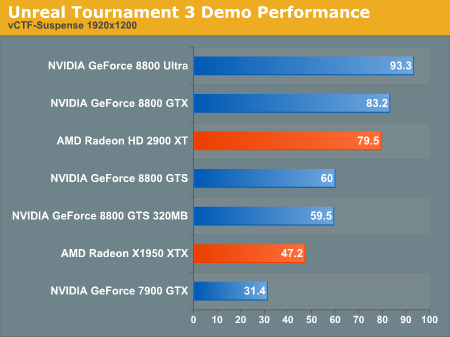
The NVIDIA GeForce 8800 GTX and Ultra both outperform the AMD Radeon HD 2900 XT, which is to be expected: the 2900 XT costs much less. But the performance gap here is not huge, and the 2900 XT gets major points for that. It handily outperforms its direct competition, the 8800 GTS (both 640MB and 320MB perform nearly identically). Not surprisingly, the X1950 XTX bests the 7900 GTX, and both of these parts perform worse than the 8800 GTS cards.
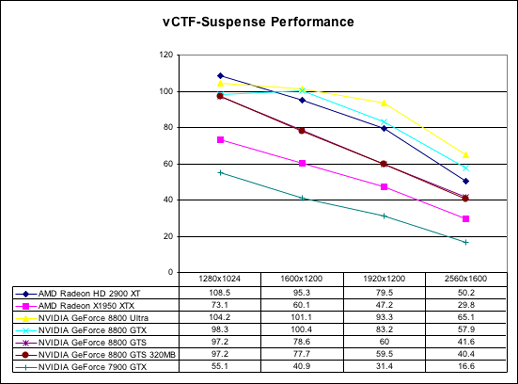
If we look at the scaling graph for Suspense, we can see that the GTS cards remain above 40fps even at 2560x1600. This is quite impressive, especially for the low memory GTS, but we do have to keep in mind that this is a flyby in a demo version of the game and we may see changes in performance between now and the final version.
Also intriguing is the fact that the high end NVIDIA hardware seems to become CPU limited at less than 1600x1200. This leads to the fact that AMD's Radeon HD 2900 XT actually outperforms the 8800 Ultra at 1280x1024. The 8800 Ultra does seem to scale very well with resolution, while the 7900 GTX drops off quickly and under performs through out the test.
While the rest of this data is very similar to what we've already presented, we did go to the trouble of running the numbers. In order to present a complete picture of what we've seen on the less demanding levels, here is the rest of our data:

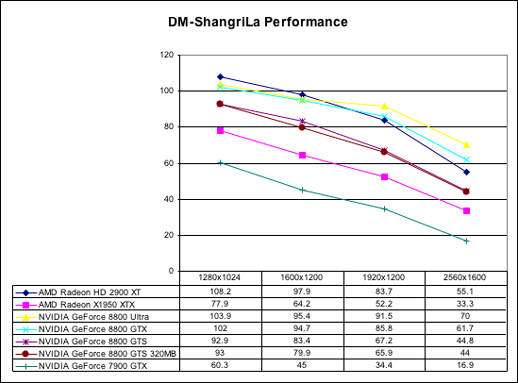
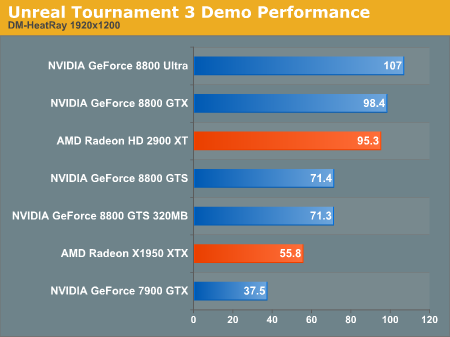
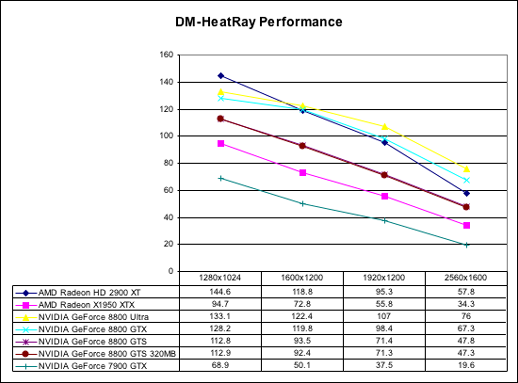
Final Words
We're just getting started with our UT3 performance analysis, but already there are some interesting conclusions to be had. Quite possibly the biggest takeaway from this comparison is the dramatic improvement in multi-threaded game development over the past couple of years. Starting from a point where none of our game benchmarks were multi-threaded just two years ago, here we are today with the latest and greatest from Epic, and seeing huge gains from one to two cores, and promising improvements when moving to four cores.
Quad-core gaming is still years away from being relevant (much less a requirement), but the industry has come a tremendous distance in an honestly very short period of time. We're more likely to have multi-threaded games these days than 64-bit versions of those titles, mostly thanks to the multi-core architecture in both the Xbox 360 and PlayStation 3. Like it or not, but much of PC gaming development is being driven by consoles, the numbers are simply higher on that side of the fence (even though the games themselves look better on this side).
On the GPU side, NVIDIA of course does quite well with the 8800 lineup, but the real surprise is how competitive AMD is with the Radeon HD 2900 XT. There may be some salvage yet for that architecture, if AMD could only bring out a midrange part that actually offered compelling performance...










72 Comments
View All Comments
Matthew12222 - Thursday, July 17, 2008 - link
2MB L2 cache VS 4MB L2 cache! And FSB 1000mhz VS 1333mhz. THis is after proving L2 makes a big difference and Fsb a smaller one.SiliconDoc - Thursday, February 7, 2008 - link
I have been enjoying Anandtech now for many years, and have appreciated the articles I've learned so much from for so long. One of the first uses of that knowledge was passing along the review on the HOT 591P to a very good programmer friend, upon which he purchased the board for his at home portion of work.That said, I had to finally make a username so I could comment on - the bias that is so often shown against AMD here. It is often subtle, in certain wordings and in less than blatantly obvious ways, but it has bothered me for some time. I guess that's the way the cookie crumbles, everyone has a favorite, for whatever reason.
Concerning this article, I plodded along, and then found out that something was amiss once again with the tests chosen, or the equipment chosen, that resulted in a strange result, to AMD's disadvantage. I've seen it here it seems 100 times. Like good representatives, the articles writers pass along that they notified the manufacturers/companies, relieving some of the disdain for it I tasted. I wonder if AMD feels the same way. I doubt it. I suspect they are and have been angry about it.
If it was the UT3 game, or the sli board, or whatever, why was the test posted as "valid" when it scientifically proved something other than card framerate limits were amiss ?
I just can't help wondering how ragingly angry AMD reps are that view this type of thing, over and over again.
I'm not sure why the bias is so consistent here, but it is here, and I just wish it wasn't.
I've really never seen this site "unable" to diagnose the most obscure of matters when it comes to performance issues, but then again, if it's an AMD chip, often the two shoulders go up and the blank pout is given, then the applause for Intel is heartily enjoyed.
If I'm not the first person who has said something like this, good.
I don't generally read any comments, so maybe everyone has accepted the slant already and moved on.
Nonetheless I think this site is wonderful, and will no doubt be visiting it for years to come, learning and learning and learning more and more, as much as I can to help me in my endeavors.
For that, I have real way to repay the good that has been done for me, I hope that in some way exlpains why I feel fine expressing my opinion concerning the processor wars and the handling of the same by this site.
Thanks to all at anandtech and all the rest of the fans out there.
BlackOmega - Thursday, November 8, 2007 - link
Very useful article.Anyway, I would sugest you guys posted the diference in the minimum framerate attained by both processors...
I'm running a Athlon 4200+ overclocked to 2.8ghz, and after some benchmarking I found out that there are certain areas in game where the frame rate would drop severely. In fly by runs I get 100 fps + running in 1024x768, but in actual game play, places like the ShockRifle/Helmet in Shangrila make the frame rate drop to ~40 fps.
It would be nice if you guys could test those areas and see how the diferent processors affect minimum frame rate / specially heavy areas of the map.
I'm also very interested in how cache affects AMD's processors performance.
Nil Einne - Saturday, October 27, 2007 - link
Historically, AMD's A64 architecture has been a lot less cache sensitive then the Intel's C2. It would have been interesting to see how the A64 performance depended on cache akin to the C2 but sadly you didn't test this.Tuvokkk - Sunday, October 21, 2007 - link
please anand let us know the command to run the flyby benchs and the settings u used so that we can compare our resultsZoomer - Friday, October 19, 2007 - link
How much disk space does the beta demo take up? I tried to install the 700mb installer and it complains that there's insufficient disk space, even though I have 20gb free in my partition containing my programs and user data, and >200GB spread out over a few other partitions.Or does it do a dumb check of c:\ ? That could be a problem; my c partition is only 4 gigs big and contains only windows files.
TSIMonster - Thursday, October 18, 2007 - link
I'd like to see how the 2900 does with the addition of AA & AF. Typically, that is where it falls behind slightly. The architecture seems fine, its just the power usage and lack of AA & AF support that gets me thus far.poohbear - Thursday, October 18, 2007 - link
thanks anandtech for a great article!!!! very detailed and informative stuff. cheers again for the article and i hope u revisit it when the full game comes out. Mind u, were u using DX10 or 9 and can u do a comparison on this end too?mongoosesRawesome - Thursday, October 18, 2007 - link
I'm wondering if the large discrepancy in performance between 1M and 4M cache CPU's remains when you turn up the frequency? It seems that a lot of people are buying the lower clocked pentium dual cores and overclocking them to 3GHz speeds. Could you compare the chips in that situation in order to see if the cache matters as much at high frequencies as it does at low frequencies?shuffle2 - Wednesday, October 17, 2007 - link
I would love to see the game run with hardware physics enabled - with both the card installed and also with only the software installed. I currently run the beta demo on highest settings available, including hardware acceleration, and no errors are thrown up at any time. also, the game performs very, very smoothly.